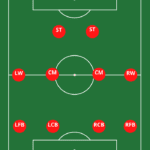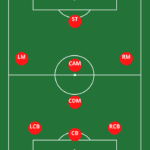Soccer History and Timeline
- Author - Andy Long
- Last Updated -
What is the history of Soccer / Football?

Ever wondered where soccer began? Did ancient civilizations kick around stones for fun, or was it the Greeks who first brought a version of the game to life during their Olympic Games? Let’s lace up our cleats, get into the spirit of the game, and take a thrilling journey through the history of soccer.
From its earliest roots to the global phenomenon it is today, soccer’s story is one of evolution, culture, and enduring passion. This post delves into the origins of the sport, exploring how it has transformed over centuries into the beloved game we know as “the beautiful game.”
So, buckle up, fuel your curiosity, and join us as we uncover the fascinating milestones in soccer’s history. From its ancient beginnings to the modern spectacle it has become, you’re about to score some incredible historical insights! Let’s kick things off!
When did soccer/football begin?
The first known examples of a team game involving a ball seemed to happen in Mesoamerican cultures about over 3,000 years ago- SOCCER.
A game played by the Aztecs called Tchatali. History tells a tail that In some ritual occasions, the ball would symbolize the sun and the captain of the losing team would be sacrificed to the gods. One of the interesting historical notes is a bouncing ball made of rubber was used – no other early culture had access to rubber.
 One of the first known ball game that also involved kicking…
One of the first known ball game that also involved kicking…
took place In China in the 3rd and 2nd century BC under the name of cuju. Cuju was played with a round ball on an area of a square playing field. The ball was stitched leather with fur or feathers inside. A modified form of this game later spread to Japan and was by the name of kemari practiced under ceremonial forms.
Another version of a ball games was known from Ancient Greece.
The ball was made by shreds of leather filled with hair. At this time ball games had a low status and were not included at the Panhellenic Games. In the Ancient Rome, games that included balls were not allowed in the entertainment on the big arenas. Insted, they were used for exercises in the military by the name of Harpastum.
It seems, Roman culture brought football to the British island (Britannica).
 It important to note that this early form of football involved lots of participants and used a big area of play.
It important to note that this early form of football involved lots of participants and used a big area of play.
A vary similar game was played if Florence and was called Calcio in the 16th century.
These games caused damage to cities and sometimes death to participants. Theses are a few reasons the game was forbidden for several centuries. Although if returned to the streets of London in the 17th century. The football-like games would return to the streets of London in the 17th century. It would be forbidden again in 1835, but at this stage the game had been established in the public schools.
In addition to the history of soccer, click below ,If you are looking for information on Soccer Positions, Soccer Formations.

The Game of Football Takes Form – History of Soccer
According to the most commonly accepted account, the origins of football can be traced back to England in the 12th century.
During this era, variations of the game that resembled modern-day football were played on fields and roads throughout the country. The game involved kicking a ball, as well as using one’s fists to punch the ball.
However, it’s worth noting that the early form of football was considerably more aggressive and violent than the contemporary version of the game.
It took, however, long time until the features of today’s football had been taken into practice. For a long time there was no clear distinction between football and rugby. There were also many variations concerning the size of the ball, the number of players and the length of a match.
The game was often played in schools and two of the predominant schools were Rugby and Eton. At Rugby the rules included the possibility to take up the ball with the hands and the game we today know as rugby has its origin from here. At Eton on the other hand the ball was played exclusively with the feet and this game can be seen as a close predecessor to the modern football. The game in Rugby was called “the running game” while the game in Eton was called “the dribbling game”.
An attempt to create proper rules for the game was done at a meeting in Cambridge in 1848,
but a final solution to all questions of rules was not achieved. Another important event in the history of football came about in 1863 in London when the first Football association was formed in England. It was decided that carrying the ball with the hands wasn’t allowed. The meeting also resulted in a standardization of the size and weight of the ball. A consequence of the London meeting was that the game was divided into two codes: association football and rugby.
The game would, however, continue to develop for a long time and there was still much flexibility concerning the rules. For one thing, the number of players on the pitch could vary.  Neither were uniforms used to distinguish the appearance of the teams. It was also common with players wearing caps – the header was yet to be a part of the game yet. Further reading: The development of football rules.
Neither were uniforms used to distinguish the appearance of the teams. It was also common with players wearing caps – the header was yet to be a part of the game yet. Further reading: The development of football rules.
Another important difference at this stage could be noticed between English and Scottish teams. Whereas the English teams preferred to run forward with the ball in a more rugby fashion, the Scottish chose to pass the ball between their players. It would be the Scottish approach that soon became predominant.
The sport was at first an entertainment for the British working class. Unprecedented amounts of spectators, up to 30,000, would see the big matches in the late 19th century. The game would soon expand by British peoples who traveled to other parts of the world. Especially in South America and India would the interest in football become big.
The first football clubs – History of Soccer
Football clubs have existed since the 15th century, but unorganized and without official status. It is therefore hard to decide which the first football club was.  Some historians suggest that it was the Foot-Ball Club formed 1824 in Edinburgh. Early clubs were often formed by former school students and the first of this kind was formed in Sheffield in 1855. The oldest among professional football clubs is the English club Notts County that was formed in 1862 and still exists today.
Some historians suggest that it was the Foot-Ball Club formed 1824 in Edinburgh. Early clubs were often formed by former school students and the first of this kind was formed in Sheffield in 1855. The oldest among professional football clubs is the English club Notts County that was formed in 1862 and still exists today.
An important step for the emergence of teams was the industrialization that led to larger groups of people meeting at places such as factories, pubs and churches. Football teams were established in the larger cities and the new railroads could bring them to other cities.
In the beginning, football was dominated by public school teams, but later, teams consisting by workers would make up the majority. Another change was successively taking place when some clubs became willing to pay the best players to join their team. This would be the start of a long period of transition, not without friction, in which the game would develop to a professional level.
The motivation behind paying players was not only to win more matches. In the 1880s the interest in the game has moved ahead to a level that tickets were sold to the matches. And finally, in 1885 professional football was legalized and three years later the Football League was established. During the first season, 12 clubs joined the league, but soon more clubs became interested and the competition would consequently expand into more divisions.
For a long time, the British teams would be dominant. After some decades, clubs from Prague, Budapest and Sienna would be the primarily contenders to the British dominance.
As with many things in history, women were for a long time excluded from participating in games. It was not before the late 19th century that women started to play football. The first official women’s game took place in Inverness in 1888.
The first competitions – History of Soccer
Other milestones were now to follow. Football Association Challenge Cup (FA Cup) became the first important competition when it was run in 1871. The following year a match between two national teams was played for the first time. The match that involved England and Scotland ended 0-0 and was followed by 4,000 people at Hamilton Crescent (the picture shows illustrations from this occasion). Twelve years later, in 1883, the first international tournament took place and included four national teams: England, Ireland, Scotland and Wales.
Football was for a long time a British phenomenon, but it gradually spread to other European countries. The first game that took place outside Europe occurred in Argentina in 1867, but it was foreign British workers who were involved and not Argentinean citizens.
The Fédération Internationale de Football Association (FIFA) was founded in 1904 and a foundation act was signed by representatives from France, Belgium, Denmark, the Netherlands, Spain, Sweden and Switzerland. England and the other British countries did not join FIFA from the start, they had invented the game and saw no reason to subordinate to an association. Still, they joined in the following year, but would not partake in the World Cup until 1950.
Domestic leagues occurred in many countries. The first was, as already mentioned, the English Football League which was established in 1888. The leagues would by time expand by more divisions, which were based on team performance.
In 1908 would football for the first time be included as an official sport in the Olympic Games. Until the first FIFA World Cup was played in 1930, the Olympic Games football tournament would rank as the most prestigious on a national level. Women’s football was not added until 1996.
Black players – As in many other sports the white male was predominant for a long time. In football black players started being present relatively early and in comparison with, for example, tennis, football has traditionally been known as a sport with a mix of black and white players.
In Britain, Andrew Watson is known to be the first black player, and he played in the Scottish club Queen’s Park in the 1880s.
A game of passion – History of Soccer
Few other sports show examples of passion to that extent as football. The arenas are flocked by shearing people; and in front of television even more are watching carefully and sometimes with great enthusiasm.
 Already in the late 19th century, Goodison Park was built in England in purpose of hosting football games. In 1894, the FA Cup final between Notts County and Bolton Wanderers was attended by 37,000 people. A milestone in the development of football stadiums is the construction of Maracanã Stadium. In the year of 1950 the imposing stadium in Rio de Janeiro was ready for almost 200,000 people. No other sport has seen stadiums of that capacity built to host its games.
Already in the late 19th century, Goodison Park was built in England in purpose of hosting football games. In 1894, the FA Cup final between Notts County and Bolton Wanderers was attended by 37,000 people. A milestone in the development of football stadiums is the construction of Maracanã Stadium. In the year of 1950 the imposing stadium in Rio de Janeiro was ready for almost 200,000 people. No other sport has seen stadiums of that capacity built to host its games.
There have been two different traditions of fan culture on the arenas: the British and the South American. The British fans adopted the tradition of singing, the repertoire was inspired from pub and working songs among other areas. The South Americans on the other hand would adopt the carnival style which included firecrackers and fireworks, and also the modern phenomena of Bengali fires. Fans in other countries have later adopted a mixture of these traditions.
The great modern competitions – History of Soccer
No other sport event besides the Summer Olympic Games can today measure itself with the FIFA World Cup. The first edition of the FIFA World Cup was played in 1930 in Uruguay and has since then returned every fourth year (with two exceptions due to the Second World War). In 1991 the first World Cup for women was held in China and has since then also returned every fourth year.
Today the biggest global tournament for clubs is the Champions League (played since 1992), the former European Cup (1955–1991).
Globalization of the biggest sport in the world
In the late 19th century, only a few national football teams existed; England and Scotland had the first active teams that played games against each other in the 1870s. Today there are 211 national associations included in the Fédération Internationale de Football Association (FIFA), the world governing body of the sport. Another proof of the globalization could be seen in the increase of nations participating in the World Cup qualifiers: from 32 in 1934 to over 200 in 2014.
The world regions have been divided into six confederations: Confédération Africaine de Football (CAF), Asian Football Confederation (AFC), Union des Associations Européennes de Football (UEFA), The Confederation of North, Central America and Caribbean Association Football (CONCACAF), Oceania Football Confederation (OFC), and Confederación Sudamericana de Fútbol (CONMEBOL).
Football is definitely a global sport and without comparison the biggest in the world. A quote from David Goldblatt’s book The Ball is Round is one way to answer why:
It offers the spotlight for individual brilliance while relishing the defiance and heart of collective endeavor. It has staged tragedy and comedy, epic and pantomime, unsophisticated music hall and inaccessible experimental performances. It does imperious triumph, lucky escapes, impossible comebacks and stubborn stalemates. It captures the brilliance of unpredictability, the uncertainty of the human heart and human skill, of improvisation and chance.
The name of the game: football or soccer?
In most parts of the world, football is used as the name for the “chess of the green pitch”, the biggest sport in the world. In the United States and Canada, however, soccer is used instead as a distinction from American football. A more formal name sometimes used is association football, but in popular speech, it is either football or soccer.
Soccer (Football) Timeline - History of Soccer
5000-300 B.C.
There is evidence in China that military forces around 2nd and 3rd century BC (Han Dynasty) played a game, originally named “Tsu Chu”, that involved kicking a leather ball stuffed with fur into a small hole. Like Soccer, no hands were permitted during the play of the game.
2500 B.C
There was possibly a version of a type of ball game played by young women in Egypt during the age of Baqet III, as images of this sport were depicted on his tomb, though there is not much known of this sport except that it was played with a ball.
1000 B.C.
The Japanese version of ‘soccer’ was called Kemari, a game much like modern hacky sack, played with two to twelve players, and played a larger ball stuffed with sawdust. There was also a field designated by four trees (cherry, maple, pine and willow).
B.C. In ancient Greece, they played a game called Episkyros, in which two equal numbered teams would try to throw the ball over the heads of the other team. There was a white line between the teams and another white line behind each team. Teams would change the ball often until one of the team was forced behind the line at their end.
50 B.C.
China’s Tsu Chu players and Japan’s Kemari players were the first to have an “International” game of their versions of soccer, believed to have occurred roughly 50 B.C.. There is a definite date of such a game occurring in 611 A.D.
600 – 1600 A.D.
In Mexico & Central America the rubber ball was created, and used in a game on a recessed court 40-50 feet long shaped like a capital “I”. In the middle of each wall, was a mounted stone or wooden ring and the object was to project the hard rubber ball through the ring.
700s
The first Football games played in Britain was between the locals of east of England, starting after a ‘legendary’ game that involved kicking around the severed head of a Danish prince that they had defeated in a war. These games were violent, where injury and death were not uncommon
1331
Despite the violence of these celebratory games, they were still popular. This led King Edward III of England to pass laws in 1331 to stop the game
1424
King James I of Scotland also passed a law banning the game
1500
In Italy they played a game called “calcio” with teams of 27+ people. The game involved kicking, carrying or passing a ball across a goal line. In 1580, Giovanni Bardi published a set of rules of the game of calcio.
1572
Queen Elizabeth I of England, enacted laws that could sentence a football player to jail for a week followed by penance in a church.
1600
In Alaska and Canada the native Eskimos played a game called aqsaqtuk on ice, using balls stuffed with grass, caribou hair, and moss. One legend tells of two villages playing against each other with goals 10 miles apart.
1605
Football became legal again in England
1620
In North America, native American Indians in the original Jamestown settlement played a game called pasuckuakohowog, meaning “they gather to play ball with the foot.” It was a rough game, played the beach, the field a half-mile wide with goals 1 mile apart, with as many as 1000 players at a time.
1815
Eton College of England established a set of rules for the games.
1820
In the USA, football was played among the Northeastern universities and colleges of Harvard, Princeton, Amherst and Brown.
1848
The rules were further standardized and a new version was adopted by all the schools, college and universities, known as the Cambridge Rules.
1862
The first soccer club formed anywhere outside of England was the Oneida Football Club, Boston USA.
1863 October 26 of 1863,
the Football Association was formed when eleven London schools and clubs came together at the Freemason’s Tavern to establish a single set of rules to administer any football match that were to be played among them. On December 8 1863, Association Football and Rugby Football finally split into two different organizations. Later in the year, the first ever soccer match was played on Barnes common at Mortlake, London on 19th December 1863 between Barnes Football Club and Richmond Football Club. The game ended in a 0-0 draw.
1869
The Football Association rules were further amended to exclude any handling of the ball.
1872
The first official international football match was played, between the national teams of Scotland and England, played in Glasgow Scotland. The game was played on 30 November 1872, and finished with a 0-0 draw.
1883
The four British associations agreed on a uniform code and formed the International Football Association Board.
1885
The first international match played by teams outside of Great Britain was between USA and Canada, played in Newark and ended with Canada winning 1-0.
1888
Introduction of the penalty kick.
1900
Soccer played at the Olympic Games for the first time
1904
Establishment of FIFA by delegates from France, Belgium, Denmark, the Netherlands, Spain, Sweden and Switzerland at a meeting in Paris on the 21st of May.
1930
In 1930, The Federation Internationale de Football Association (FIFA) held soccer’s first World Cup tournament in Montevideo, Uruguay, with 13 teams.
1932
Soccer was taken off the program for the Olympic Games in Los Angeles, due to a controversy between FIFA and the IOC over the definition of amateur and the reluctance of many strong soccer countries to travel to the US because of the expense involved.
1991
The inaugural Women’s World Cup in 1991 in China was won by the United States
1996
The American women’s team won the first-ever women’s soccer event at the Olympics.
1996
Major League Soccer (MLS) is introduce as the top USA professional soccer league.
1998
Real Betis break the £20m record for a transfer, spending £21.5m on Brazilian winger Denilson.
France defeated Brazil 3-0 in Paris to lift the World Cup for the very first time.
1998
3 billion people follow World Cup in France.
1998
Joseph S. Blatter succeeds Joao Havelange as FIFA President.
1999
Christian Vieri becomes the first £30m player when he is transferred from Lazio to Inter Milan.
1999
Women’s World Cup Final in Los Angeles marks the largest ever attendance for a women’s sporting event in world history. USA beat China in front of 90,185 fans. This Woman’s World Cup had over 658,000 attendees and over 1 billion television viewers worldwide, thus not only putting women’s soccer but also women’s sport into mainstream society forever.
2000
Brazil hosts the first FIFA Club World Championship, won by Corinthians of Brazil.
2001
Zinedine Zidane is the first £40m player when Real Madrid broke the world transfer record again by agreeing to a £46m deal with Juventus for the Frenchman.
2002
Korea and Japan co-host the first World Cup outside Europe and the Americas.
2009
Cristiano Ronaldo becomes the most expensive player in the world when he came from Manchester United to Real Madrid for £80m.
2010
First ever World Cup tournament is played on African soil in Johannesburg, South Africa on 11th June at 4pm with the match between the hosts South Africa and Mexico.
 One of the first known ball game that also involved kicking…
One of the first known ball game that also involved kicking… 

















